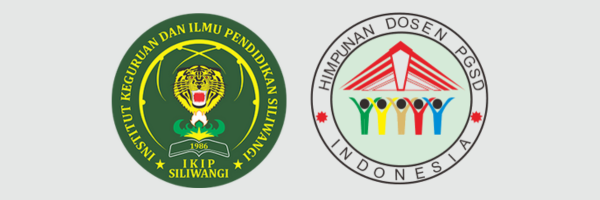TYPES OF LITERACY LEARNING IN EARLY GRADES: WHAT DOES THE TEACHER DO?
DOI:
https://doi.org/10.22460/pej.v5i2.2639Abstract
Literacy has become a major component of learning. In early elementary schools, children must be taught early reading skills to build a higher grades literacy foundation. The teacher determines literacy learning performance in the classroom because it plays a vital role in the front line of learning. The main objective of this research was to describe the process of learning literacy in elementary schools. This study used a survey method involving five principals and thirty elementary school teachers. Interviews were used as instruments to describe literacy learning in elementary school. Data obtained from the field were tabulated and presented. This study showed that the methods or models and learning media used by the teacher were different. The teacher had also shown an effort to increase children's motivation in participating in literacy learning.
Keywords: Early literacy, early grade elementary school, elementary school teachers.
References
Alper, B., Riche, N. H., Chevalier, F., Boy, J., & Sezgin, M. (2017). Visualization literacy at elementary school. In Proceedings of the 2017 CHI Conference on Human Factors in Computing Systems (pp. 5485-5497). https://doi.org/10.1145/3025453.3025877
Armbruster, B. B. (2010). Put reading first: The research building blocks for teaching children to read: Kindergarten through grade 3. Diane Publishing.
Baker, L., & Wigfield, A. (1999). “Dimensions of children's motivation for reading and their relations to reading activity and reading achievementâ€. Reading research quarterly, Vol 34 no. 24, pp 452-477. https://doi.org/10.1598/rrq.34.4.4
Beers, C. S., Beers, J. W., & Smith, J. O. (2009). A principal's guide to literacy instruction. Guilford Press.
Bruner, JS. (1965) “The growth of mindâ€. American Psychologist, Vol. 20 No. 12, p 1007.
Cunningham, A. E., & Stanovich, K. E. (1997). Early reading acquisition and its relation to reading experience and ability 10 years later. Developmental psychology, 33(6), 934-944. https://doi.org/10.1037/0012-1649.33.6.934
Day, S. L., Connor, C. M., & McClelland, M. M. (2015). Children's behavioral regulation and literacy: The impact of the first grade classroom environment. Journal of school psychology, 53(5), 409-428. https://doi.org/10.1016/j.jsp.2015.07.004
Elhassan, Z., Crewther, S. G., & Bavin, E. L. (2017). The contribution of phonological awareness to reading fluency and its individual sub-skills in readers aged 9-to 12-years. Frontiers in psychology, 8, 533. https://doi.org/10.3389/fpsyg.2017.00533
Grigg, W., Moran, R., & Kuang, M. (2010). National Indian Education Study--Part I: Performance of American Indian and Alaska Native Students at Grades 4 and 8 on NAEP 2009 Reading and Mathematics Assessments. NCES 2010-462. National Center for Education Statistics.
Glasow, P. A. (2005). Fundamentals of survey research methodology. Retrieved January, 18, 2019.
Ian O'Byrne, W., & Pytash, K. E. (2017). Becoming literate digitally in a digitally literate environment of their own. Journal of Adolescent & Adult Literacy, 60(5), 499-504. https://doi.org/10.1002/jaal.595
International Reading Association, & National Association for the Education of Young Children. (1998). Learning to read and write: Developmentally appropriate practices for young children. International Reading Association.
Juel, C. (1988). Learning to read and write: A longitudinal study of 54 children from first through fourth grades. Journal of educational Psychology, 80(4), 437. https://doi.org/10.1037/0022-0663.80.4.437
Justice, L. M., & Sofka, A. E. (2013). Engaging children with print: Building early literacy skills through quality read-alouds. Guilford Publications.
Kikas, E., Peets, K., & Hodges, E. V. (2014). Collective student characteristics alter the effects of teaching practices on academic outcomes. Journal of Applied Developmental Psychology, 35(4), 273-283. https://doi.org/10.1016/j.appdev.2014.04.004
Kuhn, M. R., & Levy, L. (2015). Developing fluent readers: Teaching fluency as a foundational skill. Guilford Publications.
McLean, SA, Wertheim, EH, Masters, J., & Paxton, SJ (2017) “A pilot evaluation of a social media literacy intervention to reduce risk factors for eating disorders. International Journal of Eating Disorders, Vol. 50 no.7, pp 847–851. https://doi.org/10.1002/eat.22708
Ministry of Education and Culture, Indonesian National Assessment Program (INAP) results. 2016 available https://puspendik.kemdikbud.go.id/inap-sd/category. AccessDecember 23 2020
Musthafa, B. (2008).“Dari Literasi dini ke literasi tekhnologiâ€. Bandung: CREST, Center for Research on Education.
Musthafa, B. (2014). “Literasi dini dan literasi remaja: Teori, Konsep, dan Praktik’. Bandung: Crest.
Permendikbud No. 23 tahun 2015
Piaget, J. (1985). The equilibration of cognitive structures: The central problem of intellectual development. University of Chicago Press.
Pressley, M. (2002). “Effective beginning reading instructionâ€. Journal of literacy research, Vol 34. no.2, pp 165-188. https://doi.org/10.1207/s15548430jlr3402_3
Progress in International Reading Literacy Study International Report. 2006. Accessed Januari 20, 2020. http://timssandpirls.bc.edu/pirls2006/intl_rpt.html
Puspita, R. D., Sunendar, D., Musthafa, B., & Agung, R. (2017). Improving Students Reading Comprehension Ability Through Integrated Thematic Learning With School Literacy Movement Support. Jurnal Pendidikan Humaniora, 5(3), 99-103. https://doi.org/10.17977/um030v5i32017p099
Reutzel, D. R., & Cooter, R. B. (2012). Teaching Children to Read: The Teacher Makes the Difference 6th Edition. Pearson
Roskos, K. A., Christie, J. F., & Richgels, D. J. (2003). The Essentials of Early Literacy I Early Literacy Instruction. Young Children, 58(2), 52-60.
Ruddell, R. B., & Ruddell, M. R. (2004) “Teaching children to read and writeâ€. Allyn & Bacon.
Stipek, D., & Byler, P. (2004). The early childhood classroom observation measure. Early Childhood Research Quarterly, 19(3), 375-397. https://doi.org/10.1016/j.ecresq.2004.07.007
Tang, X., Pakarinen, E., Lerkkanen, M. K., Muotka, J., & Nurmi, J. E. (2019). Longitudinal associations of first-grade teaching with reading in early primary school. Journal of Applied Developmental Psychology, 63, 23-32. https://doi.org/10.1016/j.appdev.2019.05.002
Tompkins, G. (2017). Literacy for the 21st century A Balanced Approach. Pearson.
Vernon-Feagans, L., Mokrova, I. L., Carr, R. C., Garrett-Peters, P. T., Burchinal, M. R., & Family Life Project Key Investigators. (2019). Cumulative years of classroom quality from kindergarten to third grade: Prediction to children’s third grade literacy skills. Early Childhood Research Quarterly, 47, 531-540. https://doi.org/10.1016/j.ecresq.2018.06.005
Vygotsky, L. S., van der Veer, R. E., Valsiner, J. E., & Prout, T. T. (1994). The Vygotsky reader. Basil Blackwell.
Winarni, E. W., Hambali, D., & Purwandari, E. P. (2020). Analysis of Language and Scientific Literacy Skills for 4th Grade Elementary School Students through Discovery Learning and ICT Media. International Journal of Instruction, 13(2), 213-222. https://doi.org/10.29333/iji.2020.13215a
Wolf, S., Turner, EL, Jukes, MCH, & Dubeck, MM (2018). “Changing literacy instruction in Kenyan classrooms: Assessing the pathways of influence to improved early literacy outcomes in the HALI interventionâ€. International Journal of Educational Development, Vol. 62. July., pp 27–34. 2017. https://doi.org/10.1016/j.ijedudev.2018.02.004
Wortham, S. C. (2006). Early childhood curriculum: Developmental bases for learning and teaching. Kevin M. Davis.












